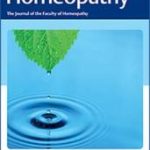Prashant S.Chikramane, Akkihebbal K.Suresh, Shantaram G.Kane, Jayesh R.Bellare
Metal nanoparticle induced hormetic activation: a novel mechanism of homeopathic medicines
Homeopathy, 2017, 106 (3), 135-144

Background – High-potency homeopathic remedies, 30c and 200c have enormous dilution factors of 1060 and 10400 respectively. Therefore, the presence of physical entities in them is inconceivable. As a result, their efficacy is highly debated and often dismissed as a placebo. Despite several hypotheses postulated to explain the claimed homeopathic efficacy, none have satisfactorily answered the qualms of the sceptics. Against all beliefs and principles of conventional dilution, we have shown that nanoparticles (NPs) of the starting metals are unequivocally found in the 30c and 200c remedies at concentrations of a few pg/ml. In this paper, our aim was to answer the important question of whether such negligible metal concentrations elicit a biological response. Methods – Metal-based homeopathic medicines (30c and 200c) were analysed at doses between 0.003%v/v and 10%v/v in in-vitro HepG2 cell-line. Upon treatment, cell response was estimated by MTT assay, FACS and total intracellular protein. Experiments were performed to discern whether the hormesis was a cell-activation or a proliferation effect. Results – Remedies at doses containing a few femtograms/ml levels of the starting metals induced a proliferation-independent hormetic activation by increasing the intracellular protein synthesis. The metal concentrations (at fg/ml) were a billion-fold lower than the studies with synthetic NPs (at μg/ml). Further, we also highlight a few plausible mechanisms initiating a hormetic response at a billion-fold lower dose. Conclusions – Hormetic activation has been shown for the first time with standard homeopathic high-potency remedies. These findings should have a profound effect in understanding these extreme dilutions from a biological perspective.






Lascia un commento
Devi essere connesso per inviare un commento.